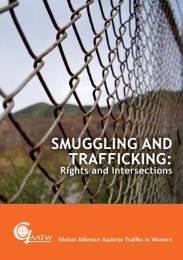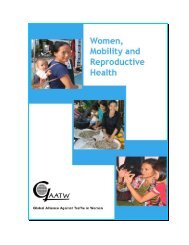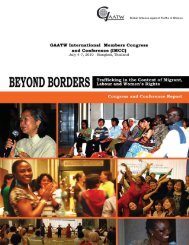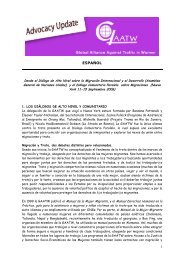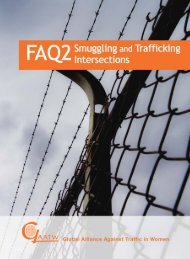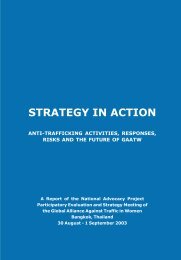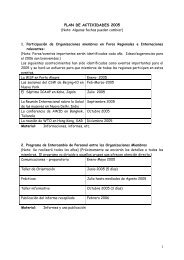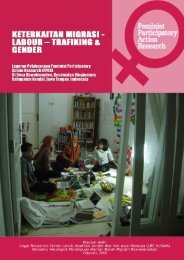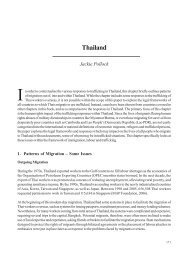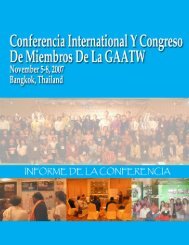Exploring Links between Trafficking and Migration - Global Alliance ...
Exploring Links between Trafficking and Migration - Global Alliance ...
Exploring Links between Trafficking and Migration - Global Alliance ...
- No tags were found...
Create successful ePaper yourself
Turn your PDF publications into a flip-book with our unique Google optimized e-Paper software.
<strong>Exploring</strong> <strong>Links</strong> <strong>between</strong> <strong>Trafficking</strong> <strong>and</strong> <strong>Migration</strong>2010 feminist participatory action research projects by GAATW members<strong>and</strong> allies, women stressed their familial roles as the most importantfactor determining their migration <strong>and</strong> labour experiences (e.g. servingas the motivation for leaving, invoking family ideals to help withst<strong>and</strong>exploitation). At the same time, migration was being perceived assomething that detracted from their ability to mother their children intheir home village. Women were emphatic about the emotional <strong>and</strong> socialcosts of family separation <strong>and</strong> the impact their migration or migrationstatus had on their ability to parent (for more analysis of this, pleaserefer to the Working Paper on <strong>Links</strong> with Gender 49 ).Avoiding Protectionism of Women: Protect RightsInsteadAnti-trafficking measures are commonly developed to “protect women”,rather than to protect their rights. This has led to women from someorigin countries being denied the right to leave their country: Forexample, in GAATW’s study Collateral Damage: The Impact of Anti-<strong>Trafficking</strong> Measures on Human Rights Around the World, the IndianGovernment considered women migrant workers a “particularly vulnerablelot” <strong>and</strong> “issued an order prohibiting any female household worker belowthe age of 30 from being employed in the Kingdom of Saudi Arabiaunder any circumstance.” 50 To avoid this ban, women had to take riskiermigration options than their male counterparts, making them morevulnerable to abuse at the destination point.Destination countries have also closed their borders in misguided attemptsat protection. Many Brazilian women attempting to enter the EuropeanUnion have been repeatedly denied entrance <strong>and</strong> repatriated on thegrounds that immigration officials thought they looked like “prostitutes”<strong>and</strong> thus were likely to be trafficked. 51The preventative or “helping” language used does not hide the violationsof women’s rights to freedom of movement <strong>and</strong> freedom fromdiscrimination. More empowering strategies must be found.Culturally we live in a world that sees women as needing protection.Some anti-trafficking measures feed into this way of thinking becausethey are usually focused on women’s vulnerabilities (rather than theirrights or strengths), <strong>and</strong> on women who have been very badly hurt.Through our research, we found women’s movements were restricted inanti-trafficking shelter homes, which was often done in the name of“helping” trafficked persons <strong>and</strong> ensuring their safety. 52 Though menare also trafficked, most measures are geared at women, <strong>and</strong> designedin a way to protect them by restricting what they are allowed to do,rather than empowering them to be strong actors in whatever they do.Avoiding All Forms of Discrimination Against WomenWomen face discrimination based on gender, along with discriminationagainst other identities (such as class, race, sexuality, age, etc.) even inwhat are considered good migration programmes. Some programmesare especially designed for women’s participation, but discriminate againstthem based on whether they are married or have children. Many migrationmeasures ask women to leave the country if they are pregnant; men, of17



